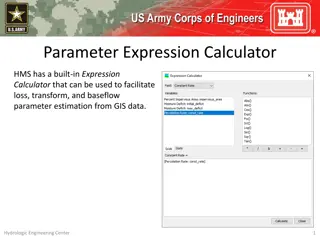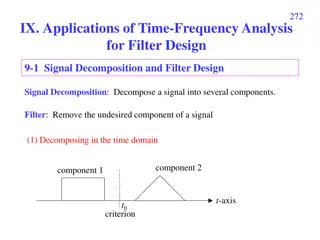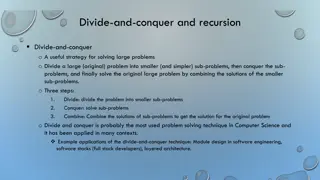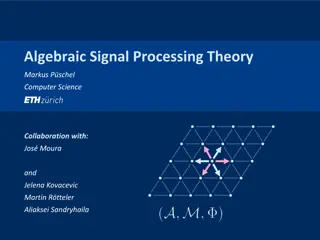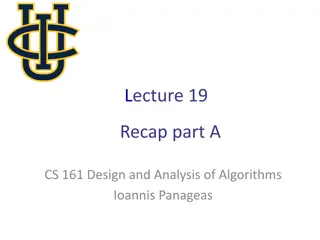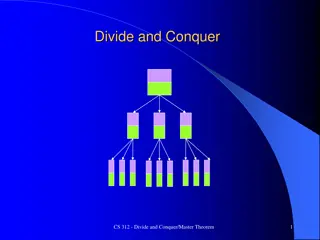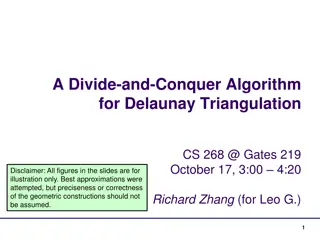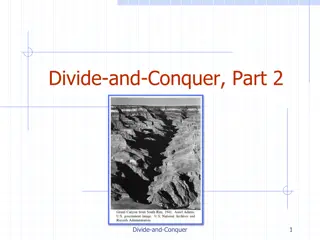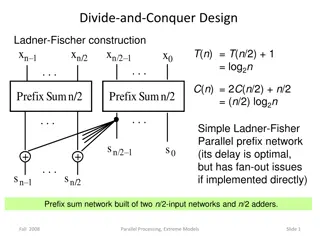
Methods for Sorting, Searching, and Problem Transformation in Algorithm Design
Explore in-depth analysis of sorting and searching algorithms like Selection Sort, Merge Sort, Quick Sort, and techniques such as Transform and Conquer. Understand how problems can be transformed and solved in a structured manner using Heaps. Learn about the construction and properties of Heaps in algorithm design.
Download Presentation

Please find below an Image/Link to download the presentation.
The content on the website is provided AS IS for your information and personal use only. It may not be sold, licensed, or shared on other websites without obtaining consent from the author. If you encounter any issues during the download, it is possible that the publisher has removed the file from their server.
You are allowed to download the files provided on this website for personal or commercial use, subject to the condition that they are used lawfully. All files are the property of their respective owners.
The content on the website is provided AS IS for your information and personal use only. It may not be sold, licensed, or shared on other websites without obtaining consent from the author.
E N D
Presentation Transcript
Velalar College of Engineering and Technology (Autonomous) Department of CSE (Accredited by NBA) 18ITT42 - DESIGN AND ANALYSIS OF ALGORITHMS (IV-Semester) Handled By: Dr.V.Latha Jothi , Professor
UNIT II Analysis of Sorting and Searching Algorithms Brute Force Selection Sort and Bubble Sort - Divide and conquer Merge sort Quick Sort- Strassen s Matrix Multiplication -Decrease and Conquer Insertion Sort Transform and Conquer-Heaps and Heap sort- Analysis of Linear Search and Binary search techniques
TRANSFORM AND CONQUER * Problems under these methods work as two-stage procedures. * First, in the transformation stage, the problem s instance is modified to be, more amenable to solution. * Then, in the second or conquering stage, it is solved. * Three major variations: instance simplification: Transformation to a simpler instance of the same problem representation change: Transformation to a different representation of the same instance problem reduction: Transformation to an instance of a different problem for which an algorithm is already available
HEAPS * A heap can be defined as a binary tree with keys assigned to its nodes, one key per node, provided the following two conditions are met: The shape property the binary tree is essentially complete, i.e., all its levels are full except possibly the last level, where only some rightmost leaves may be missing. The parental dominance or heap property the key in each node is greater than or equal to the keys in its children.
HEAPS Properties of a Heap * There exists exactly one essentially complete binary tree with n nodes. Its height is equal to log2n. * The root of a heap always contains its largest element. * A node of a heap considered with all its descendants is also a heap. * A heap can be implemented as an array by recording its elements in the top-down, left-to-right fashion. H[0] either unused or putting there a sentinel whose value is greater than every element in the heap. In such a representation, the parental node keys will be in the first n/2 positions of the array, while the leaf keys will occupy the last n/2 positions; the children of a key in the array s parental position i (1 i n/2) will be in positions 2i and 2i + 1, and, correspondingly, the parent of a key in position i (2 i n) will be in position i/2.
HEAPS Construction of a Heap (Bottom up approach) * Bottom-up heap construction. Starting with the last parental node, checks whether the parental dominance holds for the key If not, exchange the node s key K with the larger key of its children and checks whether the parental dominance holds for K in its new position. Repeat above step until the parental dominance for K is satisfied. After completing the heapification of the subtree rooted at the current parental node, proceeds to do the same for the node s immediate predecessor. The algorithm stops after this is done for the root of the tree.
HEAPS Construction of a Heap (Bottom up approach)
HEAPS Construction of a Heap (Bottom up approach) ALGORITHM HeapBottomUp(H[1..n]) //Constructs a heap from elements of a given array by the bottom-up algorithm //Input: An array H[1..n] of orderable items //Output: A heap H[1..n] for i floor(n/2) downto 1 do k i; v H[k] heap false while not heap and 2 k n do j 2 k if j < n if H[j] < H[j+1] j j + 1 if v H[j ] heap true else H[k] H[j]; k j H[k] v
Analysis of Heap Construction Algorithm * Consider the heap is full i.e. n = 2k 1 so that a heap s tree is full, (k is no. of levels) * Let h be the height of the tree * Each key on level i of the tree will travel to the leaf level h in the worst case of the heap construction algorithm. * Moving a key to the next level down requires two comparisons one to find the larger child and the other to determine whether the exchange is required * The total number of key comparisons involving a key on level i will be 2(h i). * Therefore, the total number of key comparisons in the worst case is * A heap of size n can be constructed with fewer than 2n comparisons
HEAPS Construction of a Heap (Top Down approach) * Top-down heap construction. Let key k be the new node value to be added to the heap. Add k to the heap. Shift k up to its appropriate place in the new heap as follows. Compare k with its parent s key: if the latter is greater than or equal to k , stop otherwise, swap these two keys and compare k with its new parent. This swapping continues until k is not greater than its last parent or it reaches the root.
To insert 10 into the heap Obviously, this insertion operation cannot require more key comparisons than the heap s height. Since the height of a heap with n nodes is about log2n, the time efficiency of insertion is in O(log n).
Deletion in a Heap Maximum Key Deletion from a heap * Exchange the root s key with the last key K of the heap. * Decrease the heap s size by 1. * Heapify the smaller tree by sifting K down the tree verifying the parental dominance for K: if it holds, we are done; if not, swap K with the larger of its children and repeat this operation until the parental dominance condition holds for K in its new position. * Efficiency of deletion is determined by the number of key comparisons needed to heapify the tree approximately O(n log n)
Heap Sort Two-stage algorithm * Stage 1 (heap construction): Construct a heap for a given array. * Stage 2 (maximum deletions): Apply the root-deletion operation n 1 times to the remaining heap. Perform Heap Sort for the given set of elements 2, 9, 7, 6, 5, 8 * Stage 1 (heap construction) 2 9 7 2 9 8 2 9 8 9 2 8 9 6 8 6 6 6 6 2 5 5 5 5 5 8 7 7 7 7
Heap Sort Stage 2 (maximum deletions) 9 6 8 2 5 7 7 6 8 2 5 9 (heapify) 8 6 7 2 5 9 5 6 7 2 89 (heapify) 7 6 5 2 89 2 6 5 7 89 (heapify) 6 2 5 7 89 (heapify) 6 7 5 2 89 (heapify) 7 6 5 2 89 2 6 5 789 (heapify) 6 2 5 789 5 2 6789 2 56789 2 5 6789
Heap Sort - Efficiency * For heap construction(stage 1), efficiency is O(n) * For maximum deletions(stage 2), efficiency is O(n log n) Therefore, * The efficiency of the heap sort algorithm is O(n) + O(n log n) i.e. O(n log n) * The efficiency of the heap sort algorithm in both the worst and average cases is (n log n) * The efficiency of the merge sort algorithm is (n log n), but heap sort doesn t require extra space. * Timing experiments on random files show that heapsort runs more slowly than quicksort but can be competitive with mergesort




